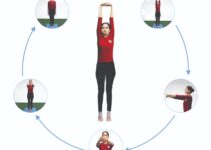
Headstand Yoga Pose overview
Several people are apprehensive and disinterested in doing Sirsasana because of its headstand position and require some balance. It is easy to practice if it is performed under the guidance of an expert and providing the basic rules are carefully followed. The brain needs well-oxygenated blood to perform its various functions smoothly. However, in the case of passive and general people, the brain doesn’t receive sufficient enriched oxygenated blood, which leads to headaches, pituitary malfunctioning, diabetes, sexual problems, improper vision, hair fall, skin conditions, piles, varicose veins, etc.
The scientific experiment has verified that the amount of air breathed per minute during the performance of headstand yoga was considerably reduced. Oxygen consumption by the tissues increased, and the amount of oxygen exhaled was less, indicating that oxygen transfer to the blood was significantly increased. It has also been shown that the number of WBC has increased, thus prevents the body from infections and developing immunity. It also prevents blood stagnation in the lower parts of the body, thus ensuring a homogenous blood supply to the entire body. The ideal practice time is early morning, just before breakfast.
How to do headstand yoga
Mastering Sirsasana is a relatively easy task. Once this is achieved, then staying in the final pose is a little tricky. Here are the ten simple and easy steps to raise the body into the final pose and how to become a master headstand yoga.
- Interlock the fingers tightly, palms forming a cup.
- Place the head on the formed cup so that the crown of the head touches the palms.
- Raise the knees from the floor by pulling the toes towards the head. You can slowly raise your legs upwards from the bottom.
- After the body is adequately balanced, gradually and slowly straighten the legs.
- Take care that you maintain equilibrium and don’t fall backwards.
- Make sure that the spine and thighs are in line, straight and vertical.
- Relax the whole body as much as possible.
- Close the eyes
- Breathe slowly and deeply.
- This is the final pose of sirsasana. Please return to the final pose for a relaxing time by flexing the knees and sliding them down to the floor in reverse order.
Top benefits of Headstand Yoga Pose
- Sirsasana supplies enriched oxygenated blood to the brain cells, thus providing nourishment to the billions of brain cells.
- It helps to rejuvenate, revitalise, and increases the effectiveness of brain cells.
- It induces calmness and thus prevents headaches and migraines.
- It controls various glandular and nervous disorders related to pituitary glands.
- The pose has a significant favourable influence on relieving diabetes. It acts directly on the pituitary gland by improving the blood supply and thus has been a great help in combating diabetes.
- It is highly beneficial in combating sexual disorders such as prostate problems, hydrocele, leucorrhea, spermatorrhea, and all general menopausal and menstrual ailments.
- It acts upon the thyroid gland and helps to balance metabolic functions.
- It improves the functions of the sensory organs by ensuring an adequate supply of blood to these organs.
- The conditions like myopia, astigmatism, catarrh, and general bad hearing are improved by regular practice of it.
- It allows an oxygen-rich blood flow to the facial skin, thus improving the facial complexion.
- It is good to prevent hair fall, baldness, and greying of hair by supplying enriched blood and nutrients to the scalp region.
- People suffering from losing sleep, memory, and vitality have recovered through the regular practice of this asana.
- It relieves colds, coughs, tonsillitis, halitosis, and palpitations.
- RBC formation also increased after the regular practice of it.
Precautions
I’d like for you to observe the following precautions while performing Sirsasna.
- Keep the whole body vertical in the final pose; don’t incline backwards, forwards, or sideways.
- Relax as many muscles as possible in the final position.
- Ensure that most of the body’s weight is supported on the head in the final position, not in the arms.
- One should practice this yoga pose just after doing other asanas.
- Practice it before Pranayama and meditative yoga pose.
- A person suffering from high blood pressure, heart malfunctioning, cerebral or coronary thrombosis, arteriosclerosis, conjunctivitis, chronic glaucoma, haemorrhage in the head, Otia, chronic catarrh, slipped disc, kidney problems should not practice sirsasana.
- In the case of highly impure blood, the impurities could be directed into the brain.
- It also shouldn’t perform when your bowel is exceptionally complete, you feel physically tired, and you have headaches or migraines.
- Practicing it is avoided after intense physical exercise as vigorous workout releases toxins in the body that may reach the brain.
- During pregnancy or menstruation.
- Sirsasna should be immediately stopped if you experience a headache, feel dizziness, sweat profusely, become very hot, or have palpitation of the heart.
Sirsasana duration
The duration for practicing the headstand pose varies from person to person. A person performing this pose for years can practice for up to 30 minutes. For beginners, 30 seconds is good, and the maintenance time may be increased up to 5 minutes under the guidance of an expert.
Counterpose
Tadasana and Shavasana are different simple yoga poses that can be performed just after practicing headstand yoga. The stick asana can also be performed. Massaging the body is also one of the options. After completing sirsasana, the counterpose is of utmost importance to smooth the various body functions.
Headstand yoga side effects
While doing sirsasana, the practitioner should be relaxed and calm to avoid contradictory results.







please advise the inhale and exhale of air during sirsasana and how?
On sirsasana position, how the breathe can be controlled. How long the breathe should be held and how it is released through nostrils. please comment.
Not to hold breath. Simply breath calmly and deeply. Relax in shavasana for atleast 5 to 10 mins after sirsasana. This asana is called king of all asanas.
I also do Susana two days.but after two days..some pain in my left chest..and also so weekends what is the problem.how can I cure my body from this problem….and also.said it why…I feel so week
Is it ok to do the headstand while taking eltroxine and what are the effects
Thank you
Is sirsasana help to reduce thigh size or cellulite of lower body?
yes it will shape ur thigh perfectly
No Link with thigh ….but eye sight will be perfect and mind will be sharperned
yes it will.
I did for a month but after the excercises how can i makeup for the losse
When should i do this pose. I mean in the morning before breakfast? Or evening.
Can we do it after having food?
When it will be more beneficial?
Do it on empty stomach… light meal prior to 2 hrs is ok
it is fine to do sirsasan when one suffers from tinnitus
What is age limits of sirshasana?
7 to 70 years.
I practice Sirsasana at 81.
how long after taking water we can do it
After one hour, one can do it.
Can i do in sinusitis problem
Yes, but in the presence of a yoga teacher.
What can we eat after sirsasan?
can i perform this pose if i am suffering from shortness of breadth
It should be avoided. If you want to practice the simpler version, it is better to consult a Yoga expert.
Sirsasana done correctly keeps a person young and sound throughout life.After this shabasana to be performed.
After drinking water ,can we practice head stand?
Of course. But do it after half an hour.
After drinking water ,can we practice headstand
Do it after 30 to 40 minutes.
will this help to lose weight
sure
good article love it
namaste,can i increase the headstand upt0 30min because i’m able to for 18min.
Thank you
Instead of increasing the time, it is better to focus on stability, concentration, breathing and above all the yogic aura around the posture.
If this aasan is harmless for asthmatic patients….
If you want to practice it, Do it in the presence of a Yoga Therapist.
It can be help in repair damage scalp
During shirshasana should i closed my eyes or open???
The beginner should keep his eye open. But after having perfection, you may close your eyes.
Can I perform it after dand baithak.
Can I do it after running?
No
it is really hard yoga I tried many times but failed.
Sirshasan is really the king of asanas. Sad, it was not practiced by all yogasadhakas,more out of imaginary fears.